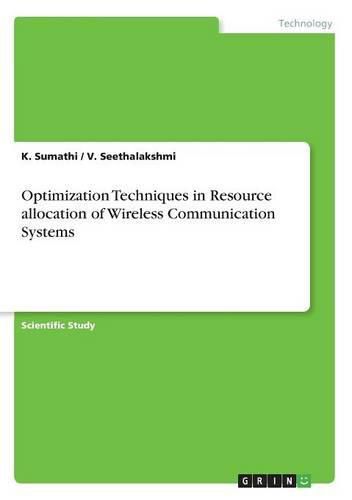Readings Newsletter
Become a Readings Member to make your shopping experience even easier.
Sign in or sign up for free!
You’re not far away from qualifying for FREE standard shipping within Australia
You’ve qualified for FREE standard shipping within Australia
The cart is loading…






Scientific Study from the year 2016 in the subject Engineering - Communication Technology, Mahalingam College of Engineering and Technology, language: English, abstract: The future Wireless Communication Systems (WCS) are supposed to provide high data rate to support personal and multimedia communications irrespective of the users’ mobility and location. These services include heterogeneous classes of traffics such as voice, file transfer, web browsing, wireless multimedia, teleconferencing, and interactive games. In recent years, data and multimedia services have become important in wireless communications. As a result, bandwidth requirement and number of users become delicate problems. To support high data rate requirement for future WCS, it is essential to efficiently allocate the limited resources. The major challenges are the dynamic nature of wireless channel, limited resources such as power, frequency spectrum, and diversified Quality of Service (QoS) requirements. Orthogonal Frequency Division Multiplexing (OFDM) is a special case of multicarrier transmission that supports high data rate operation. OFDM is a modulation and multiplexing technique appropriate for current and future wireless networks. OFDM divides the available bandwidth into a number of parallel independent orthogonal subchannels and their bandwidth is much less than the coherence bandwidth of the channel. The wide band frequency selective fading channel is converted into several narrow band flat fading channels. OFDM is an excellent method to overcome multipath fading effects. One of the goals of WCS is to enhance the capacity of the channel. Multiple Access Technique (MAT) permits several mobile users to share the given bandwidth in an effective way. Basically there are four multiple access techniques available namely, Time Division Multiple Access (TDMA), Frequency Division Multiple access (FDMA), Code Division Multiple Access (CDMA) and Space Division Multiple Access (SDMA). MAT is employ
$9.00 standard shipping within Australia
FREE standard shipping within Australia for orders over $100.00
Express & International shipping calculated at checkout
Scientific Study from the year 2016 in the subject Engineering - Communication Technology, Mahalingam College of Engineering and Technology, language: English, abstract: The future Wireless Communication Systems (WCS) are supposed to provide high data rate to support personal and multimedia communications irrespective of the users’ mobility and location. These services include heterogeneous classes of traffics such as voice, file transfer, web browsing, wireless multimedia, teleconferencing, and interactive games. In recent years, data and multimedia services have become important in wireless communications. As a result, bandwidth requirement and number of users become delicate problems. To support high data rate requirement for future WCS, it is essential to efficiently allocate the limited resources. The major challenges are the dynamic nature of wireless channel, limited resources such as power, frequency spectrum, and diversified Quality of Service (QoS) requirements. Orthogonal Frequency Division Multiplexing (OFDM) is a special case of multicarrier transmission that supports high data rate operation. OFDM is a modulation and multiplexing technique appropriate for current and future wireless networks. OFDM divides the available bandwidth into a number of parallel independent orthogonal subchannels and their bandwidth is much less than the coherence bandwidth of the channel. The wide band frequency selective fading channel is converted into several narrow band flat fading channels. OFDM is an excellent method to overcome multipath fading effects. One of the goals of WCS is to enhance the capacity of the channel. Multiple Access Technique (MAT) permits several mobile users to share the given bandwidth in an effective way. Basically there are four multiple access techniques available namely, Time Division Multiple Access (TDMA), Frequency Division Multiple access (FDMA), Code Division Multiple Access (CDMA) and Space Division Multiple Access (SDMA). MAT is employ